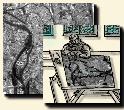 |
 |
![]()
YU, GIRAUDON and BERTHOT [S. Yu, 1994] propose a method of extraction based on a classification guided by a map. The areas of interest have the double goal
The extraction of the areas of interest starting from the digitized map is interactive. The areas selected fit a preset criterion about texture and are used as binary mask on the image. The image is thus divided into two a priori classes, ``urban areas'' and ``not-urban areas''.
Some texture indicators describe the aspect of the urban zones. The choice of these indicators is significant and they must be as independent as possible. The approach first consists in calculating the values of all the indicators available on the samples, then to use these values in a Bayesian classification. The indicators which give the best result are selected. The evaluation of the results is carried out by comparison with a ground truth. Another possibility consists in using correlation matrices to choose the less correlated indicators.
The image is then modelled with a MRF (Markov Random Fields) formalism. A pixel can belong to each class with a certain probability. The a priori probabilities are deduced from starting knowledge. Then, a relaxation algorithm calculates, in an iterative way, the propagation of probabilities. The idea is that a urban zone is supposed to extend with time (often, the maps are old) and the growth rate can be deduced from the rate of population growth.
The algorithm tends to maximize the a posteriori probability of the membership of the classes. Texture indicators define the conditional probability for a pixel, and its environment, to belong to a class. The growth rate is calculated, then confronted with that hoped.
The error conditions the revision of the probabilities: if the calculated rate is lower than the hoped rate, the probability of the `` urban area'' class is increased, that of `` not-urban area'' class is decreased, and vice versa. The process is reiterated until obtaining the desired growth rate. The pixels for which the probability to belong the `` urban area'' class is maximum are kept.